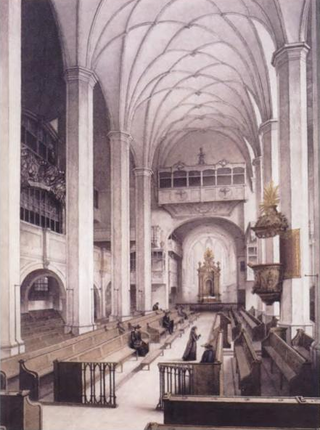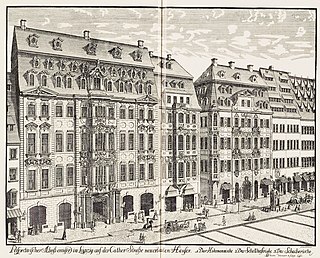The Canonic Trio Sonata in F major is a short piece by Johann Sebastian Bach, catalogued as BWV 1040. [1] [2] The instrumentation is for oboe, violin, and basso continuo (generally a combination of cello and harpsichord or such). Played adagio, the 27-measure, common time piece is less than two minutes long.
It was probably first performed on 23 February 1712 (or 1713). [3] Besides being a stand-alone piece, Bach also incorporated it into the soprano aria Weil die wollenreichen Herden (While the flocks rich in wool) in the Hunting Cantata BWV 208 [4] and into an aria Mein gläubiges Herze (My faithful heart) in Cantata BWV 68. [5] In fact in his book The Faber Pocket Guide to Bach Sir Nicholas Kenyon dismisses the piece saying "The trio BWV 1040 does not really need a number of its own since it is the wholly delightful trio sonata that springs as a postlude from Cantata 208 and then Cantata 68". [6] Nevertheless, it is performed in its own right as an instrumental piece. [7] [8] [9] [10]

The viola d'amore is a 7- or 6-stringed musical instrument with sympathetic strings used chiefly in the baroque period. It is played under the chin in the same manner as the violin.
The trio sonata is a genre, typically consisting of several movements, with two melody instruments and basso continuo. It originated in the early 17th century and was a favorite chamber ensemble combination in the Baroque era.

The Brandenburg Concertos by Johann Sebastian Bach are a collection of six instrumental works presented by Bach to Christian Ludwig, Margrave of Brandenburg-Schwedt, in 1721. The original French title is Six Concerts Avec plusieurs instruments, meaning "Six Concertos for several instruments". Some of the pieces feature several solo instruments in combination. They are widely regarded as some of the greatest orchestral compositions of the Baroque era.
The Bach-Werke-Verzeichnis is a catalogue of compositions by Johann Sebastian Bach. It was first published in 1950, edited by Wolfgang Schmieder. The catalogue's second edition appeared in 1990. An abbreviated version of that second edition, known as BWV2a, was published in 1998.

Trevor David Pinnock is a British harpsichordist and conductor.

Gottfried Heinrich Stölzel was a German composer of the Baroque era.

Was mir behagt, ist nur die muntre Jagd, BWV 208.1, BWV 208, also known as the Hunting Cantata, is a secular cantata composed by Johann Sebastian Bach, belatedly for the birthday of Duke Christian of Saxe-Weissenfels on 27 February 1713. A performance lasts about forty minutes. The aria "Schafe können sicher weiden" is the most familiar part of this cantata.

The keyboard concertos, BWV 1052–1065, are concertos for harpsichord, strings and continuo by Johann Sebastian Bach. There are seven complete concertos for a single harpsichord, three concertos for two harpsichords, two concertos for three harpsichords, and one concerto for four harpsichords. Two other concertos include solo harpsichord parts: the concerto BWV 1044, which has solo parts for harpsichord, violin and flute, and Brandenburg Concerto No. 5 in D major, with the same scoring. In addition, there is a nine-bar concerto fragment for harpsichord which adds an oboe to the strings and continuo.

Peter Watchorn is an Australian-born harpsichordist who has combined a virtuosic keyboard technique, musical scholarship and practical experience in the construction of harpsichords copied from original instruments of the 17th and 18th centuries. As well as presenting many solo public performances and broadcasts of baroque keyboard music and participating in choral and orchestral performances, he has made numerous commercial CD recordings of solo harpsichord music from the 17th and 18th centuries.
Giovanni Benedetto Platti was born possibly 9 July 1697 in Padua, then belonging to Venice. He was an Italian Baroque composer and oboist. He died 11 January 1763 in Würzburg.

Wahrlich, wahrlich, ich sage euch, BWV 86, is a church cantata by Johann Sebastian Bach. He composed it in Leipzig for Rogate, the fifth Sunday after Easter, and first performed it on 14 May 1724.

Johann Sebastian Bach composed the church cantata Barmherziges Herze der ewigen Liebe, BWV 185 in Weimar for the fourth Sunday after Trinity and first performed it on 14 July 1715.

The Sonata in G major for two flutes and basso continuo, BWV 1039, is a trio sonata by Johann Sebastian Bach. It is a version, for a different instrumentation, of the Gamba Sonata, BWV 1027. The first, second and fourth movement of these sonatas also exist as a trio sonata for organ.
Ich steh mit einem Fuß im Grabe, BWV 156, is a church cantata by Johann Sebastian Bach. He composed it in Leipzig for the third Sunday after Epiphany and first performed it in 1727 or 1729. The cantata is well known for its opening sinfonia for orchestra and oboe solo.
The Telemann-Werke-Verzeichnis, abbreviated TWV, is the numbering system identifying compositions by Georg Philipp Telemann, published by musicologist Martin Ruhnke.

The sonatas for viola da gamba and harpsichord, BWV 1027–1029, are three sonatas composed by Johann Sebastian Bach for viola da gamba and harpsichord. They probably date from the late 1730s and early 1740s.
This page is based on this
Wikipedia article Text is available under the
CC BY-SA 4.0 license; additional terms may apply.
Images, videos and audio are available under their respective licenses.









